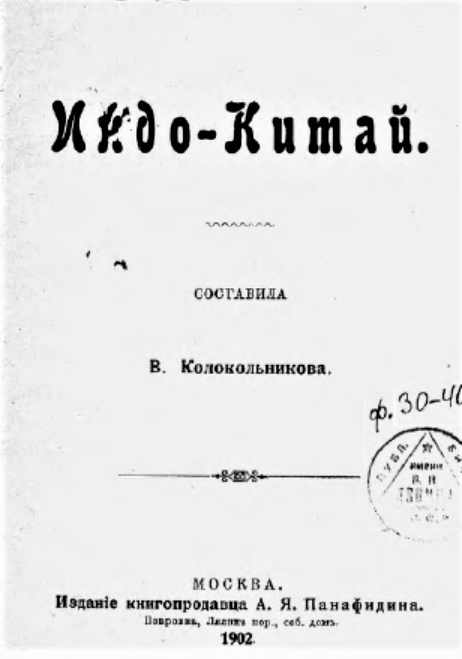Индо-Китай (Indochina)
by Vera Y. Kolokolnikova
The first popularization book on Indochina published in Russia. Authored by a bestselling female writer.

Type: e-book
Publisher: A.Y. Panafidin, Moscow, 1902 | Electronic version through Национальная электронная библиотека, https://rusneb.ru/
Published: 1902
Author: Vera Y. Kolokolnikova
Pages: 76
Language : Russian
Popular writer Vera Kololoknikova had already published short books on the Caucasus, Japon, China, India, Arabia, ‘The Holy Lands’, when she turned her attention (without actually visiting the place) to “Indochina” in 1902.
Like early Russian Orientalists, the author starts her panorama with Burma (Myanmar), which was then of special interest for Russian foreign policy and diplomacy. She follows on with Siam, then Annam, reaching Cambodia on page 56.
The political status of the Cambodian State is described as follows: ‘Въ настоящее время Комбаджа признаете надъ собою протекторате (покровительство) Франціи, но король по прежнему является «неограниченнымъ властителемъ жизни и имущества» всѣхъ своихъ подданныхъ. Онъ выбираетъ по своему усмотрѣнію мандариновъ.’ (‘At the present time, Kombadzha [Cambodia as then transcribed into Russian] recognizes the protectorate (patronage) of France, but the king is still the “unlimited ruler of life and property” of all his subjects. He chooses his mandarins at his discretion.’)
Since the author rarely quotes her sources, one can only surmise that she studied previous, ‘real’ travel books, in particular the travel account by Grigory de Vollan published in Russia in 1895. This is quite obvious in this description of cremation rituals in Cambodia: ‘У камбоджійцевъ покойниковъ также сжигаюсь. Тѣло мертвеца находится въ гробу въ сидячемъ положеніи, и пока покойпикъ находится въ домѣ, ему подносясь домашиіе его любимыя кушанья, а родственники и знакомые приходясь поклониться тѣлу. Сожиганіе происходить на высокомъ кострѣ, подъ балда- хиномъ, при огромномъ стечеыіи народа. Хмеръ смотритъ на смерть, какъ на радость, вслѣдствіе чего сожиганіе трупа сопровождается увеселеиіями, пирами, театральными представленіями, особенно если покойникъ быль лицо знатное и богатое. (‘Among the Cambodian people, too, the deceased are cremated. The body of a dead person is in the coffin sitting position, and he is offered the home of his favorite food, and relatives and friends have to bow to the body. Burning takes place on a high bonfire, under a baldaquin, with a huge crowd around. Khmer people look at death as a joy, in which case the cremation is accompanied by amusements, feasts, theatrical performances, especially if the deceased is a noble and rich person.’)
Regarding Angkor and the Khmer Empire, the author asserts that Angkor Wat was “rediscovered in 1861”, noting about the royal path through Angkor Thom: ‘Когда-то это шоссе тянулось на десятки миль и приводило къ храмамъ въ честь Брамы, Сивы и Вишну. Широкія подъѣздныя аллеи, обставлепиыя гигантами, фантастическими животными, львами, пирамиды, галлереи, террасы со статуями и узорчатыми столбами окружали храмы, на которыхъ идо сихъ поръ сохранились надписи, отиосящіяся къ десятому вѣку.’ (‘Once upon a time, this highway stretched for tens of miles and led to temples in honor of Brahma, Siva and Vishnu. Wide driveways, ornated with giants, fantastic animals, lions, pyramids, galleries, terraces with statues and patterned pillars surrounded the temples, on which to this day there are inscriptions dating back to the tenth century.’)
Then, page 64: ‘Нашъ очеркъ Индо-Китая будетъ иеполнымъ, если мы ничего не скажемъ о Малаккѣ, этой колыбели малайскаго племени.’ (‘Our sketch of Indo-China will be incomplete if we do not say anything about Malacca, this cradle of the Malay tribe.’).
email hidden; JavaScript is requiredRead in pdf format | Читать в формате pdf
Tags: Russian researchers, travel books, 19th century, rediscovery, Annam, Burma, Siam, Malacca
About the Author

Vera Y. Kolokolnikova
Author of popularization history and geography books, Vera Yakovlevna Kolokolnikova (Колокольникова Вера Яковлевна), was a ‘very prolific and popular published author in Moscow at the turn of the century’, to quote the document ‘Russian Female Writers’.
Among her books registered at the Russian National Library (RNB), we shall mention Caucasus (Кавказ, 1898), Indochina (Индо-Китай, 1902), Land of the Rising Sun (Страна восходящего солнца,1898), Our Neighbors (Наши соседи, 1908), The Heavenly Empire (China) (Небесная Империя, 1898), The Nile (Нил, Korea (Корея, 1900), Sketches of Afghanistan, Beluchistan and Persia (Oчерки Афганистана, Белуджистанa и Персии, 1906), Across Holy Lands (по святьим землям, Сирия, Палестина, Синай, 1903), A Fabulous Country, India (Сказочная страна, Индия, 1901), Across Steppes, Deserts and Mountains, Mongolia, Tibet, Mandchuria, Dzungaria, Western Turkestan (Cреди степей, пустынь и гор, Монголия, Тибет, Мандчурия, Джунгария, Западный Туркестан, 1899), Arabia (Аравия, 1901).
V.Y. Kolokolnikova also authored a biography of Mikhail Vassilievich Lomonossov, a book on the Napoleonic Invasion (The Year 1812-Patriotic War (Двенадцатый год — Отечественная война, 1912), and numerous short stories.
